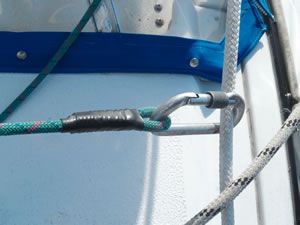Photo by Drew Frye

A stitch in time saves nine. You don’t need to tell this to a sailor. Anyone who has had his genoa split at the leach, or watched as an aging canvas awning is torn to shreds in a squall, knows all about stitching. But stitching instead of splices?
When Practical Sailor contributor Drew Frye proposed a study of stitched eyes instead of eye splices, the old salts at PS rolled their eyes. Sure, whipping twine has been used for centuries on tall ships, but so have belaying pins, fish oil, and pine tar. The cordage used on a sailboat today is a far cry from the hemp that trimmed the spanker on a brigantine. Not only are new synthetic fibers stronger, the construction is tighter and smoother.
To understand this project, it helps to know a little about Frye. When its too cold to sail his 32-foot PDQ catamaran, hes often climbing ice. Frye isn’t alone in this two-sport passion. Back in the 1990s, noted British adventurer Sir Chris Bonington teamed up with sailing legend Sir Robin Knox-Johnston (winner of the first solo, around-the-world race) for a gripping sailing and climbing adventure above the Arctic Circle, as described in the 1992 book Sea, Ice and Rock.
As it turns out, in just about any popular sailing harbor in the world, you are liable to bump into at least one climber-sailor. (They are easy to recognize by the way they look for any excuse to scramble up the mast.)
Fryes research began when he noticed that stitched handiwork was commonly used in climbing gear, but almost never in sailing equipment. Realizing that some of his aging, no-longer-spliceable double-braids would be prime candidates for a test of stitched eyes, he began stitching.
Frye stitched eyes in the ends of a variety of lines on his boat, mostly lines that still had plenty of life in them, but could no longer be spliced; these ranged from genoa sheets to anchor snubbers. The initial results led to a series of lab tests, comparing the breaking strength of the stitched eyes to knots. Again and again, his results showed that the ropes gave out before the stitched eyes, at loads comparable to a conventional splice. Ultimately, Frye broke so many old ropes with positive results that even our dubious tech staff began to think he was on to something.
There are several caveats to using stitched eyes, and Fryes study is not complete. Questions remain about protecting the stitching from chafe and ultra-violet rays, long-term durability, and how well they hold up to flogging. However, his research has convinced us that re-purposing old, unspliceable ropes by stitching a new eye is a viable option for some non-critical purposes.
We would not recommend stitched eyes for big-boat halyards or other critical high-load areas except as a temporary measure when a knot wont work. But, we can think of a number of places on our own boat where a stitched splice will be handy.
The stitched-splice research possibly could be applied to new ropes as well. Some of the ultra-high molecular weight (UHMW) lines being used for various purposes are tricky to splice or resist splicing altogether. Stitched eyes may be an option for these lines.
At present, were just scratching the surface of this topic, but the next time a double-braid line on my boat needs a new splice, I might well reach for a palm and needle-and try not to stab myself.


































As a climber sailor, stitched eyes, sewn webbing loops and the like make a lot of sense. What manufacturers are doing more and more in the climbing world and your photograph shows it, is to cover the sewn section with heat shrink. This will help protect the exposed stiches from UV exposure and abrasion, which is where the danger lies.